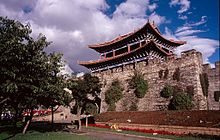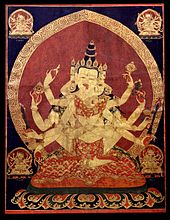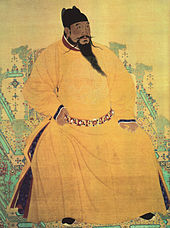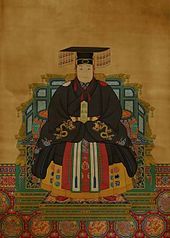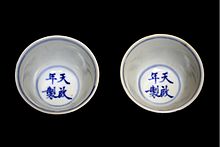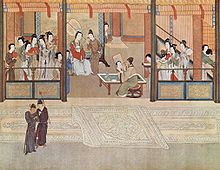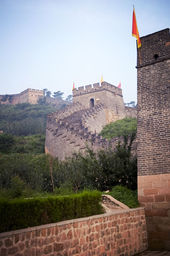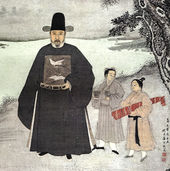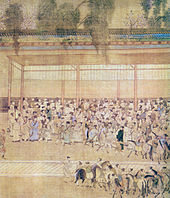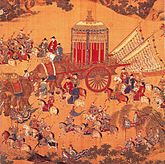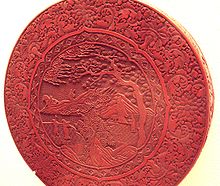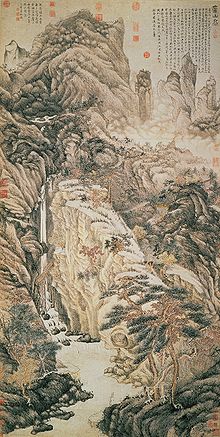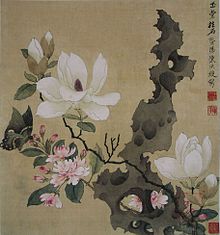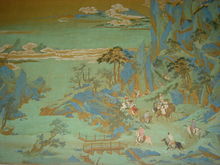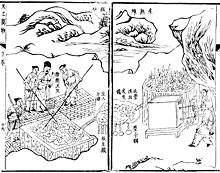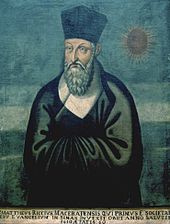
Ming Dynasty
Did you know...
SOS believes education gives a better chance in life to children in the developing world too. Before you decide about sponsoring a child, why not learn about different sponsorship charities first?
| Great Ming 大明 |
|||||
|
|||||
|
Ming China at its greatest extent under the reign of the Yongle Emperor
|
|||||
| Capital | Nanjing (Yingtian prefecture) (1368–1644) Beijing (Shuntian prefecture) (1403–1644) |
||||
| Languages | Official language: Guanhua Chinese Other Chinese dialects: Wu, Yue, Min, Xiang, Hakka, Gan Other languages: Uyghur, Tibetan, Mongolian, others |
||||
| Religion | Taoism, Confucianism, Buddhism, Chinese folk religion, Islam | ||||
| Government | Absolute monarchy | ||||
| Emperor ( 皇帝) | |||||
| - | 1368–1398 | The Hongwu Emperor | |||
| - | 1627–1644 | The Chongzhen Emperor | |||
| Senior Grand Secretary | |||||
| - | 1402–1407 | Xie Jin | |||
| - | 1644 | Wei Zaode | |||
| History | |||||
| - | Established in Nanjing | January 23, 1368 | |||
| - | Fall of Beijing to Li Zicheng | April 25, 1644 | |||
| - | End of the Southern Ming | January 22, 1662 | |||
| Area | |||||
| - | 1415 | 6,500,000 km² (2,509,664 sq mi) | |||
| Population | |||||
| - | 1393 est. | 65,000,000 | |||
| - | 1403 est. | 66,598,337¹ | |||
| - | 1500 est. | 125,000,000² | |||
| - | 1600 est. | 160,000,000³ | |||
| Currency | Bimetallic: copper cashes (文, wén) in strings of coin and paper Silver taels (兩, liǎng) in sycees and by weight |
||||
| Remnants of the Ming Dynasty ruled southern China until 1662, a dynastic period which is known as the Southern Ming. ¹The numbers are based on estimates made by CJ Peers in Late Imperial Chinese Armies: 1520–1840 ²According to A. G. Frank, ReOrient: global economy in the Asian Age, 1998, p. 109 ³According to A. Maddison, The World Economy Volume 1: A Millennial Perspective Volume 2, 2007, p. 238 |
|||||
| Ming Dynasty | |||||||||||||||||||
|---|---|---|---|---|---|---|---|---|---|---|---|---|---|---|---|---|---|---|---|
| Chinese | 明朝 | ||||||||||||||||||
|
|||||||||||||||||||
| Empire of the Great Ming | |||||||||||||||||||
| Traditional Chinese | 大明帝國 | ||||||||||||||||||
| Simplified Chinese | 大明帝国 | ||||||||||||||||||
|
|||||||||||||||||||
| History of China | |||||||
|---|---|---|---|---|---|---|---|
| ANCIENT | |||||||
| 3 Sovereigns and 5 Emperors | |||||||
| Xia Dynasty 2100–1600 BCE | |||||||
| Shang Dynasty 1600–1046 BCE | |||||||
| Zhou Dynasty 1045–256 BCE | |||||||
| Western Zhou | |||||||
| Eastern Zhou | |||||||
| Spring and Autumn period | |||||||
| Warring States period | |||||||
| IMPERIAL | |||||||
| Qin Dynasty 221 BCE–206 BCE | |||||||
| Han Dynasty 206 BCE–220 CE | |||||||
| Western Han | |||||||
| Xin Dynasty | |||||||
| Eastern Han | |||||||
| Three Kingdoms 220–280 | |||||||
| Wei, Shu and Wu | |||||||
| Jin Dynasty 265–420 | |||||||
| Western Jin | 16 Kingdoms 304–439 |
||||||
| Eastern Jin | |||||||
| Southern and Northern Dynasties 420–589 |
|||||||
| Sui Dynasty 581–618 | |||||||
| Tang Dynasty 618–907 | |||||||
| ( Second Zhou 690–705) | |||||||
| 5 Dynasties and 10 Kingdoms 907–960 |
Liao Dynasty 907–1125 |
||||||
| Song Dynasty 960–1279 |
|||||||
| Northern Song | W. Xia | ||||||
| Southern Song | Jin | ||||||
| Yuan Dynasty 1271–1368 | |||||||
| Ming Dynasty 1368–1644 | |||||||
| Qing Dynasty 1644–1911 | |||||||
| MODERN | |||||||
| Republic of China 1912–1949 | |||||||
| People's Republic of China 1949–present |
Republic of China (Taiwan) 1949–present |
||||||
|
Related articles
Chinese historiography |
|||||||
The Ming Dynasty, also Empire of the Great Ming, was the ruling dynasty of China for 276 years (1368–1644) following the collapse of the Mongol-led Yuan Dynasty. The Ming, described by some as "one of the greatest eras of orderly government and social stability in human history", was the last dynasty in China ruled by ethnic Han Chinese. Although the primary capital of Beijing fell in 1644 to a rebellion led by Li Zicheng (who established the Shun Dynasty, soon replaced by the Manchu-led Qing Dynasty), regimes loyal to the Ming throne – collectively called the Southern Ming – survived until 1662.
The Hongwu Emperor (ruled 1368–98) attempted to create a society of self-sufficient rural communities ordered in a rigid, immobile system that would guarantee and support a permanent class of soldiers for his dynasty: the empire's standing army exceeded one million troops and the navy's dockyards in Nanjing were the largest in the world. He also took great care breaking the power of the court eunuchs and unrelated magnates, enfeoffing his many sons throughout China and attempting to guide these princes through published dynastic instructions. This failed spectacularly when his teen-aged successor attempted to curtail his uncles' power, prompting the uprising that placed the Prince of Yan upon the throne as the Yongle Emperor in 1402. The Yongle Emperor established Yan as a secondary capital and renamed it Beijing, constructed the Forbidden City, and restored the Grand Canal and the primacy of the imperial examinations in official appointments. He rewarded his eunuch supporters and employed them as a counterweight against the Confucian scholar-bureaucrats. One, Zheng He, led seven enormous voyages of exploration into the Indian Ocean as far as Arabia and the coast of Africa.
The rise of new emperors and new factions diminished such extravagances; the capture of the Zhengtong Emperor during the 1449 Tumu Crisis ended them completely. The imperial navy was allowed to fall into disrepair while forced labor constructed the Liaodong palisade and connected and fortified the Great Wall of China into its modern form. Wide-ranging censuses of the entire empire were conducted decennially, but the desire to avoid labor and taxes and the difficulty of storing and reviewing the enormous archives at Nanjing hampered accurate figures. Estimates for the late-Ming population vary from 160 to 200 million, but necessary revenues were squeezed out of smaller and smaller numbers of farmers as more disappeared from the official records or "donated" their lands to tax-exempt eunuchs or temples. Haijin laws intended to protect the coasts from "Japanese" pirates instead turned many into smugglers and pirates themselves.
By the 16th century, however, the expansion of European trade – albeit restricted to islands near Guangzhou like Macao – spread the Columbian Exchange of crops, plants, and animals into China, introducing chili peppers to Sichuan cuisine and highly-productive corn and potatoes, which diminished famines and spurred population growth. The growth of Portuguese, Spanish, and Dutch trade created new demand for Chinese products and produced a massive influx of Japanese and American silver. This abundance of specie allowed the Ming to finally avoid using paper money, which had sparked hyperinflation during the 1450s. While traditional Confucians opposed such a prominent role for commerce and the newly rich it created, the heterodoxy introduced by Wang Yangming permitted a more accommodating attitude. Zhang Juzheng's initially successful reforms proved devastating when a slowdown in agriculture produced by the Little Ice Age was met with Japanese and Spanish policies that quickly cut off the supply of silver now necessary for farmers to be able to pay their taxes. Combined with crop failure, floods, and epidemic, the dynasty was considered to have lost the Mandate of Heaven and collapsed before the rebel leader Li Zicheng and a Manchurian invasion.
History
Founding
Revolt and rebel rivalry
The Mongol-led Yuan Dynasty (1271–1368) ruled before the establishment of the Ming Dynasty. Alongside institutionalized ethnic discrimination against Han Chinese that stirred resentment and rebellion, other explanations for the Yuan's demise included overtaxing areas hard-hit by inflation, and massive flooding of the Yellow River as a result of the abandonment of irrigation projects. Consequently, agriculture and the economy were in shambles and rebellion broke out among the hundreds of thousands of peasants called upon to work on repairing the dykes of the Yellow River.
A number of Han Chinese groups revolted, including the Red Turbans in 1351. The Red Turbans were affiliated with the White Lotus, a Buddhist secret society. Zhu Yuanzhang was a penniless peasant and Buddhist monk who joined the Red Turbans in 1352, but soon gained a reputation after marrying the foster daughter of a rebel commander. In 1356, Zhu's rebel force captured the city of Nanjing, which he would later establish as the capital of the Ming Dynasty.
With the Yuan Dynasty crumbling, competing rebel groups began fighting for control of the country and thus the right to establish a new dynasty. In 1363, Zhu Yuanzhang eliminated his arch rival and leader of the rebel Han faction Chen Youliang in the Battle of Lake Poyang, arguably the largest naval battle in history. Known for its ambitious use of fire ships, Zhu's force of 200,000 Ming sailors were able to defeat a Han rebel force over triple their size, claimed to be 650,000-strong. The victory destroyed the last opposing rebel faction, leaving Zhu Yuanzhang in uncontested control of the bountiful Yangtze River Valley and cementing his power in the south. After the dynastic head of the Red Turbans suspiciously died in 1367 while a guest of Zhu, there was no one left who was remotely capable of contesting his march to the throne, and he made his imperial ambitions known by sending an army toward the Yuan capital Dadu (present-day Beijing) in 1368. The last Yuan emperor fled north to Shangdu and Zhu declared the founding of the Ming Dynasty after razing the Yuan palaces in Dadu to the ground; the city was renamed Beiping in the same year. Zhu Yuanzhang took Hongwu or "Vastly Martial" as his era name.
Reign of the Hongwu Emperor
Hongwu made an immediate effort to rebuild state infrastructure. He built a 48 km (30 mi) long wall around Nanjing, as well as new palaces and government halls. The History of Ming states that as early as 1364 Zhu Yuanzhang had begun drafting a new Confucian law code, the Da Ming Lü, which was completed by 1397 and repeated certain clauses found in the old Tang Code of 653. Hongwu organized a military system known as the weisuo, which was similar to the fubing system of the Tang Dynasty (618–907).
In 1380 Hongwu had the Chancellor Hu Weiyong (胡惟庸) executed upon suspicion of a conspiracy plot to overthrow him; after that Hongwu abolished the Chancellery and assumed this role as chief executive and emperor, a precedent mostly followed throughout the Ming period. With a growing suspicion of his ministers and subjects, Hongwu established the Jinyiwei, a network of secret police drawn from his own palace guard. They were partly responsible for the loss of 100,000 lives in several purges over three decades of his rule.
South-Western frontier
In Qinghai, the Salar Muslims voluntarily came under Ming rule, their clan leaders capitulating around 1370. Uyghur troops under Uyghur general Hala Bashi suppressed the Miao Rebellions of the 1370s and settled in Changde, Hunan. Hui Muslim troops also settled in Changde, Hunan after serving the Ming in campaigns against other aboriginal tribes. In 1381, the Ming Dynasty annexed the areas of the southwest that had once been part of the Kingdom of Dali following the successful effort by Hui Muslim Ming armies to defeat Yuan-loyalist Mongol and Hui Muslim troops holding out in Yunnan province. The Hui troops under General Mu Ying, who was appointed Governor of Yunnan, were resettled in the region as part of a colonization effort. By the end of the 14th century, some 200,000 military colonists settled some 2,000,000 mu (350,000 acres) of land in what is now Yunnan and Guizhou. Roughly half a million more Chinese settlers came in later periods; these migrations caused a major shift in the ethnic make-up of the region, since formerly more than half of the population were non-Han peoples. Resentment over such massive changes in population and the resulting government presence and policies sparked more Miao and Yao revolts in 1464 to 1466, which were crushed by an army of 30,000 Ming troops (including 1,000 Mongols) joining the 160,000 local Guangxi. After the scholar and philosopher Wang Yangming (1472–1529) suppressed another rebellion in the region, he advocated single, unitary administration of Chinese and indigenous ethnic groups in order to bring about sinification of the local peoples.
Relations with Tibet
The Mingshi— the official history of the Ming Dynasty compiled later by the Qing Dynasty in 1739 —states that the Ming established itinerant commanderies overseeing Tibetan administration while also renewing titles of ex-Yuan Dynasty officials from Tibet and conferring new princely titles on leaders of Tibet's Buddhist sects. However, Turrell V. Wylie states that censorship in the Mingshi in favour of bolstering the Ming emperor's prestige and reputation at all costs obfuscates the nuanced history of Sino-Tibetan relations during the Ming era.
Modern scholars still debate on whether or not the Ming Dynasty really had sovereignty over Tibet at all, as some believe it was a relationship of loose suzerainty which was largely cut off when the Jiajing Emperor (ruled in 1521–67) persecuted Buddhism in favour of Daoism at court and some scholars argue that the significant religious nature of the relationship of the Ming court with Tibetan lamas is underrepresented in modern scholarship. Others underscore the commercial aspect of the relationship, noting the Ming Dynasty's insufficient amount of horses and the need to maintain the tea-horse trade with Tibet.
The Ming initiated sporadic armed intervention in Tibet during the 14th century, while at times the Tibetans also used successful armed resistance against Ming forays. Patricia Ebrey, Thomas Laird, Wang Jiawei, and Nyima Gyaincain all point out that the Ming Dynasty did not garrison permanent troops in Tibet, unlike the former Mongol Yuan Dynasty. The Wanli Emperor (ruled in 1572–1620) made attempts to reestablish Sino-Tibetan relations in the wake of a Mongol-Tibetan alliance initiated in 1578, the latter of which affected the foreign policy of the subsequent Manchu Qing Dynasty (1644–1912) of China in their support for the Dalai Lama of the Yellow Hat sect. By the late 16th century, the Mongols proved to be successful armed protectors of the Yellow Hat Dalai Lama after their increasing presence in the Amdo region, culminating in Güshi Khan's (1582–1655) conquest of Tibet in 1642.
Reign of the Yongle Emperor
Rise to power
The Hongwu Emperor specified his grandson Zhu Yunwen as his successor, and he assumed the throne as the Jianwen Emperor (1398–1402) after Hongwu's death in 1398. The most powerful of Hongwu's sons, Zhu Di, then the militarily mighty disagreed with this, and soon a political showdown erupted between him and his nephew Jianwen. After Jianwen arrested many of Zhu Di's associates, Zhu Di plotted a rebellion, a rebellion that sparked a three-year civil war. Under the pretext of rescuing the young Jianwen from corrupting officials, Zhu Di personally led forces in the revolt; the palace in Nanjing was burned to the ground, along with Jianwen himself, his wife, mother, and courtiers. Zhu Di assumed the throne as the Yongle Emperor (1402–1424); his reign is universally viewed by scholars as a "second founding" of the Ming Dynasty since he reversed many of his father's policies.
New capital and foreign engagement
Yongle demoted Nanjing to a secondary capital and in 1403 announced the new capital of China was to be at his power base in Beijing. Construction of a new city there lasted from 1407 to 1420, employing hundreds of thousands of workers daily. At the centre was the political node of the Imperial City, and at the centre of this was the Forbidden City, the palatial residence of the emperor and his family. By 1553, the Outer City was added to the south, which brought the overall size of Beijing to 4 by 4½ miles.

Yongle also used Zheng He's treasure fleet to expand China's tributary trade system farther afield than ever before, used woodblock printing to spread Chinese culture, and used the military (especially cavalry) to expand China's borders north into Manchuria and south into Vietnam.
Treasure fleet

Beginning in 1405, the Yongle Emperor entrusted his favored eunuch commander Zheng He (1371–1433) as the admiral for a gigantic new fleet of ships designated for international tributary missions. The Chinese had sent diplomatic missions over land and west since the Han Dynasty (202 BCE – 220 CE) and had been engaged in private overseas trade leading all the way to East Africa for centuries— culminating in the Song and Yuan dynasties —but no government-sponsored tributary mission of this grandeur and size had ever been assembled before. To service seven different tributary missions abroad, the Nanjing shipyards constructed two thousand vessels from 1403 to 1419, which included the large treasure ships that measured 112 m (370 ft) to 134 m (440 ft) in length and 45 m (150 ft) to 54 m (180 ft) in width.
Tumu Crisis and the Ming Mongols

The Oirat Mongol leader Esen Tayisi launched an invasion into Ming China in July 1449. The chief eunuch Wang Zhen encouraged the Zhengtong Emperor (r. 1435–49) to lead a force personally to face the Mongols after a recent Ming defeat; marching off with 50,000 troops, the emperor left the capital and put his half-brother Zhu Qiyu in charge of affairs as temporary regent. On September 8, Esen routed Zhengtong's army, and Zhengtong was captured—an event known as the Tumu Crisis. The Mongols held the Zhengtong Emperor for ransom. However, this scheme was foiled once the emperor's younger brother assumed the throne under the era name Jingtai (r. 1449–57); the Mongols were also repelled once the Jingtai Emperor's confidant and defense minister Yu Qian (1398–457) gained control of the Ming armed forces. Holding the Zhengtong Emperor in captivity was a useless bargaining chip for the Mongols as long as another sat on his throne, so they released him back into Ming China. The former emperor was placed under house arrest in the palace until the coup against the Jingtai Emperor in 1457 known as the "Wresting the Gate Incident". The former emperor retook the throne under the new era name Tianshun (r. 1457–64).
Tianshun proved to be a troubled time and Mongol forces within the Ming military structure continued to be problematic. On August 7, 1461, the Chinese general Cao Qin and his Ming troops of Mongol descent staged a coup against the Tianshun Emperor out of fear of being next on his purge-list of those who aided him in the Wresting the Gate Incident. Cao's rebel force managed to set fire to the western and eastern gates of the Imperial City (doused by rain during the battle) and killed several leading ministers before his forces were finally cornered and he was forced to commit suicide.
While the Yongle Emperor had staged five major offensives north of the Great Wall against the Mongols, the constant threat of Mongol incursions prompted the Ming authorities to fortify the Great Wall from the late 15th century to the 16th century; nevertheless, John Fairbank notes that "it proved to be a futile military gesture but vividly expressed China's siege mentality." Yet the Great Wall was not meant to be a purely defensive fortification; its towers functioned rather as a series of lit beacons and signalling stations to allow rapid warning to friendly units of advancing enemy troops.
Decline and fall of the Ming Dynasty
Reign of the Wanli Emperor
The financial drain of the Imjin War in Korea against the Japanese was one of the many problems—fiscal or other—facing Ming China during the reign of the Wanli Emperor (r. 1572–1620). In the beginning of his reign, Wanli surrounded himself with able advisors and made a conscientious effort to handle state affairs. His Grand Secretary Zhang Juzheng (1572–82) built up an effective network of alliances with senior officials. However, there was no one after him skilled enough to maintain the stability of these alliances; officials soon banded together in opposing political factions. Over time Wanli grew tired of court affairs and frequent political quarreling amongst his ministers, preferring to stay behind the walls of the Forbidden City and out of his officials' sight. Scholar-officials lost prominence in administration as eunuchs became intermediaries between the aloof emperor and his officials; any senior official who wanted to discuss state matters had to persuade powerful eunuchs with a bribe simply to have his demands or message relayed to the emperor.
Role of eunuchs
The Hongwu Emperor forbade eunuchs to learn how to read or engage in politics. Whether or not these restrictions were carried out with absolute success in his reign, eunuchs during the Yongle Emperor's reign and afterwards managed huge imperial workshops, commanded armies, and participated in matters of appointment and promotion of officials. The eunuchs developed their own bureaucracy that was organized parallel to but was not subject to the civil service bureaucracy. Although there were several dictatorial eunuchs throughout the Ming, such as Wang Zhen, Wang Zhi, and Liu Jin, excessive tyrannical eunuch power did not become evident until the 1590s when the Wanli Emperor increased their rights over the civil bureaucracy and granted them power to collect provincial taxes.
The eunuch Wei Zhongxian (1568–1627) dominated the court of the Tianqi Emperor (r. 1620–1627) and had his political rivals tortured to death, mostly the vocal critics from the faction of the Donglin Society. He ordered temples built in his honour throughout the Ming Empire, and built personal palaces created with funds allocated for building the previous emperor's tombs. His friends and family gained important positions without qualifications. Wei also published a historical work lambasting and belittling his political opponents. The instability at court came right as natural calamity, pestilence, rebellion, and foreign invasion came to a peak. Although the Chongzhen Emperor (r. 1627–44) had Wei dismissed from court—which led to Wei's suicide shortly after—the problem with court eunuchs persisted until the dynasty's collapse less than two decades later.
Economic breakdown and natural disasters
During the last years of the Wanli era and those of his two successors, an economic crisis developed that was centered around a sudden widespread lack of the empire's chief medium of exchange: silver. Philip IV of Spain (reigned 1621–1665) began cracking down on illegal smuggling of silver from New Spain and Peru across the Pacific towards China, in favour of shipping American-mined silver through Spanish ports. In 1639 the new Tokugawa regime of Japan shut down most of its foreign trade with European powers, cutting off another source of silver coming into China. These events occurring at roughly the same time caused a dramatic spike in the value of silver and made paying taxes nearly impossible for most provinces. People began hoarding precious silver as there was progressively less of it, forcing the ratio of the value of copper to silver into a steep decline. In the 1630s a string of one thousand copper coins equaled an ounce of silver; by 1640 that sum could fetch half an ounce; and, by 1643 only one-third of an ounce. For peasants this meant economic disaster, since they paid taxes in silver while conducting local trade and crop sales in copper.
Famines became common in northern China in the early 17th century because of unusually dry and cold weather that shortened the growing season - effects of a larger ecological event now known as the Little Ice Age. Famine, alongside tax increases, widespread military desertions, a declining relief system, and natural disasters such as flooding and inability of the government to manage irrigation and flood-control projects properly caused widespread loss of life and normal civility. The central government, starved of resources, could do very little to mitigate the effects of these calamities. Making matters worse, a widespread epidemic spread across China from Zhejiang to Henan, killing an unknown but large number of people. The deadliest earthquake of all time, the Shaanxi earthquake of 1556, occurred during the Jiajing Emperor's reign, killing approximately 830,000 people.
Rise of the Manchu
A Jurchen tribal leader named Nurhaci (r. 1616–26), starting with just a small tribe, rapidly gained control over all the Manchurian tribes. During the Japanese invasions of Korea in the 1590s, he offered to lead his tribes in support of the Ming and Joseon army. This offer was declined, but he was granted honorific Ming titles for his gesture. Recognizing the weakness of Ming authority north of their border, he united all of the adjacent northern tribes and consolidated power in the region surrounding his homeland as the Jurchen Jin Dynasty had done previously. In 1610, he broke relations with the Ming court; in 1618, he demanded the Ming pay tribute to him to redress "Seven Grievances" which he documented and sent to the Ming court. This was effectively a declaration of war, as the Ming were not about to pay money to a former tributary.
By 1636, Nurhaci's son Huang Taiji renamed his dynasty from the "Later Jin" to the "Great Qing" at Shenyang, which had fallen to Qing forces in 1621 and was made their capital in 1625. Huang Taiji also adopted the Chinese imperial title huangdi, declared the Chongde ("Revering Virtue") era, and changed the ethnic name of his people from " Jurchen" to " Manchu". In 1638 the Manchu defeated and conquered Ming China's traditional ally Joseon with an army of 100,000 troops. Shortly after, the Koreans renounced their long-held loyalty to the Ming Dynasty.
Rebellion, invasion, collapse
A peasant soldier named Li Zicheng mutinied with his fellow soldiers in western Shaanxi in the early 1630s after the Ming government failed to ship much-needed supplies there. In 1634 he was captured by a Ming general and released only on the terms that he return to service. The agreement soon broke down when a local magistrate had thirty-six of his fellow rebels executed; Li's troops retaliated by killing the officials and continued to lead a rebellion based in Rongyang, central Henan province by 1635. By the 1640s, an ex-soldier and rival to Li— Zhang Xianzhong (1606–47) —had created a firm rebel base in Chengdu, Sichuan, while Li's centre of power was in Hubei with extended influence over Shaanxi and Henan.
In 1640, masses of Chinese peasants who were starving, unable to pay their taxes, and no longer in fear of the frequently defeated Chinese army, began to form into huge bands of rebels. The Chinese military, caught between fruitless efforts to defeat the Manchu raiders from the north and huge peasant revolts in the provinces, essentially fell apart. Unpaid and unfed, the army was defeated by Li Zicheng— now self-styled as the Prince of Shun —and deserted the capital without much of a fight. On May 26, 1644, Beijing fell to a rebel army led by Li Zicheng when the city gates were treacherously opened from within. During the turmoil, the last Ming emperor hanged himself on a tree in the imperial garden outside the Forbidden City.
Seizing opportunity, the Manchus crossed the Great Wall after the Ming border general Wu Sangui (1612–1678) opened the gates at Shanhai Pass. This occurred shortly after he learned about the fate of the capital and an army of Li Zicheng marching towards him; weighing his options of alliance, he decided to side with the Manchus. The Manchu army under the Manchu Prince Dorgon (1612–50) and Wu Sangui approached Beijing after the army sent by Li was destroyed at Shanhaiguan; the Prince of Shun's army fled the capital on the fourth of June. On June 6, the Manchus and Wu entered the capital and proclaimed the young Shunzhi Emperor ruler of China. After being forced out of Xi'an by the Manchus, chased along the Han River to Wuchang, and finally along the northern border of Jiangxi province, Li Zicheng died there in the summer of 1645, thus ending the Shun Dynasty. One report says his death was a suicide; another states that he was beaten to death by peasants after he was caught stealing their food.
Scattered Ming remnants held out after 1644, including that of Koxinga (Zheng Chenggong) on Taiwan (Formosa). Despite the loss of Beijing and the death of the emperor, Ming power was by no means totally destroyed. Nanjing, Fujian, Guangdong, Shanxi, and Yunnan were all strongholds of Ming resistance. However, there were several pretenders for the Ming throne, and their forces were divided. Each bastion of resistance was individually defeated by the Qing until 1662, when the last real hopes of a Ming revival died with the Yongli emperor, Zhu Youlang. Despite the Ming defeat, smaller loyalist movements continued until the proclamation of the Republic of China.
Government
Province, prefecture, subprefecture, county

The Ming emperors took over the provincial administration system of the Yuan Dynasty, and the thirteen Ming provinces are the precursors of the modern provinces. Throughout the Song Dynasty, the largest political division was the circuit (lu 路). However, after the Jurchen invasion in 1127, the Song court established four semi-autonomous regional command systems based on territorial and military units, with a detached service secretariat that would become the provincial administrations of the Yuan, Ming, and Qing dynasties. Copied on the Yuan model, the Ming provincial bureaucracy contained three commissions: one civil, one military, and one for surveillance. Below the level of the province (sheng 省) were prefectures (fu 府) operating under a prefect (zhifu 知府), followed by subprefectures (zhou 州) under a subprefect. The lowest unit was the county (xian 縣), overseen by a magistrate. Besides the provinces, there were also two large areas that belonged to no province, but were metropolitan areas (jing 亰) attached to Nanjing and Beijing.
Institutions and bureaus
Institutional trends

Departing from the main central administrative system generally known as the Three Departments and Six Ministries system, which was instituted by various dynasties since late Han (202 BCE – 220 CE), the Ming administration had only one Department, the Secretariat, that controlled the Six Ministries. Following the execution of the Chancellor Hu Weiyong in 1380, the Hongwu Emperor abolished the Secretariat, the Censorate, and the Chief Military Commission and personally took charge of the Six Ministries and the regional Five Military Commissions. Thus a whole level of administration was cut out and only partially rebuilt by subsequent rulers. The Grand Secretariat, at the beginning a secretarial institution that assisted the emperor with administrative paperwork, was instituted, but without employing grand counselors, or chancellors. The ministries, headed by a minister and run by directors remained under direct control of the emperor until the end of the Ming.
The Hongwu Emperor sent his heir apparent to Shaanxi in 1391 to "tour and soothe" (xunfu) the region; in 1421 the Yongle Emperor commissioned 26 officials to travel the empire and uphold similar investigatory and patrimonial duties. By 1430 these xunfu assignments became institutionalized. Hence, the Censorate was reinstalled and first staffed with investigating censors, later with censors-in-chief. By 1453, the "grand coordinators"— or "touring pacifiers", as Michael Chang notes —were granted the title vice censor-in-chief or assistant censor-in-chief and were allowed direct access to the emperor. As in prior dynasties, the provincial administrations were monitored by a travelling inspector from the Censorate. Censors had the power to impeach officials on an irregular basis, unlike the senior officials who were to do so only in triennial evaluations of junior officials.
Although decentralization of state power within the provinces occurred in the early Ming, the trend of central government officials delegated to the provinces as virtual provincial governors began in the 1420s. By the late Ming Dynasty, there were central government officials delegated to two or more provinces as supreme commanders and viceroys, a system which reined in the power and influence of the military by the civil establishment.
Grand Secretariat and Six Ministries
Governmental institutions in China conformed to a similar pattern for some two thousand years, but each dynasty installed special offices and bureaus, reflecting its own particular interests. The Ming administration had the Grand Secretaries assisting the emperor, with paperwork handled by them under Yongle's reign and finally appointed as top officials of agencies and Grand Preceptor, a top-ranking, non-functional civil service post, under the Hongxi Emperor (ruled in 1424–5). The Grand Secretariat drew its members from the Hanlin Academy and were considered part of the imperial authority, not the ministerial one (hence being at odds with both the emperor and ministers at times). The Secretariat was a coordinating agency, whereas the Six Ministries—which were Personnel, Revenue, Rites, War, Justice, and Public Works—were direct administrative organs of the state. The Ministry of Personnel was in charge of appointments, merit ratings, promotions, and demotions of officials, as well as granting of honorific titles. The Ministry of Revenue was in charge of gathering census data, collecting taxes, and handling state revenues, while there were two offices of currency that were subordinate to it. The Ministry of Rites was in charge of state ceremonies, rituals, and sacrifices; it also oversaw registers for Buddhist and Daoist priesthoods and even the reception of envoys from tributary states. The Ministry of War was in charge of the appointments, promotions, and demotions of military officers, the maintenance of military installations, equipment, and weapons, as well as the courier system. The Ministry of Justice was in charge of judicial and penal processes, but had no supervisory role over the Censorate or the Grand Court of Revision. The Ministry of Works was in charge of government construction projects, hiring of artisans and laborers for temporary service, manufacturing government equipment, the maintenance of roads and canals, standardization of weights and measures, and the gathering of resources from the countryside.
Bureaus and offices for the imperial household
The imperial household was staffed almost entirely by eunuchs and ladies with their own bureaus. Female servants were organized into the Bureau of Palace Attendance, Bureau of Ceremonies, Bureau of Apparel, Bureau of Foodstuffs, Bureau of the Bedchamber, Bureau of Handicrafts, and Office of Staff Surveillance. Starting in the 1420s, eunuchs began taking over these ladies' positions until only the Bureau of Apparel with its four subsidiary offices remained. Hongwu had his eunuchs organized into the Directorate of Palace Attendants, but as eunuch power at court increased, so did their administrative offices, with eventual twelve directorates, four offices, and eight bureaus. The dynasty had a vast imperial household, staffed with thousands of eunuchs, who were headed by the Directorate of Palace Attendants. The eunuchs were divided into different directorates in charge of staff surveillance, ceremonial rites, food, utensils, documents, stables, seals, apparel, and so on. The offices were in charge of providing fuel, music, paper, and baths. The bureaus were in charge of weapons, silverwork, laundering, headgear, bronzework, textile manufacture, wineries, and gardens. At times, the most influential eunuch in the Directorate of Ceremonial acted as a de facto dictator over the state.
Although the imperial household was staffed mostly by eunuchs and palace ladies, there was a civil service office called the Seal Office, which cooperated with eunuch agencies in maintaining imperial seals, tallies, and stamps. There were also civil service offices to oversee the affairs of imperial princes.
Personnel
Scholar-officials
After the reign of Hongwu—who from 1373 to 84 staffed his bureaus with officials gathered through recommendations only—the scholar-officials who populated the many ranks of bureaucracy were recruited through a rigorous examination system that was first established by the Sui Dynasty (581–618). Theoretically the system of exams allowed anyone to join the ranks of imperial officials (although frowned upon for merchants to join); in reality the time and funding needed to support the study in preparation for the exam generally limited participants to those already coming from the landholding class. However, the government did exact provincial quotas while drafting officials. This was an effort to curb monopolization of power by landholding gentry who came from the most prosperous regions, where education was the most advanced. The expansion of the printing industry since Song times enhanced the spread of knowledge and number of potential exam candidates throughout the provinces. For young schoolchildren there were printed multiplication tables and primers for elementary vocabulary; for adult examination candidates there were mass-produced, inexpensive volumes of Confucian classics and successful examination answers.
As in earlier periods, the focus of the examination was classical Confucian texts, while the bulk of test material centered on the Four Books outlined by Zhu Xi in the 12th century. Ming era examinations were perhaps more difficult to pass since the 1487 requirement of completing the " eight-legged essay", a departure from basing essays off progressing literary trends. The exams increased in difficulty as the student progressed from the local level, and appropriate titles were accordingly awarded successful applicants. Officials were classified in nine hierarchic grades, each grade divided into two degrees, with ranging salaries (nominally paid in piculs of rice) according to their rank. While provincial graduates who were appointed to office were immediately assigned to low-ranking posts like the county graduates, those who passed the palace examination were awarded a jinshi ('presented scholar') degree and assured a high-level position. In 276 years of Ming rule and ninety palace examinations, the number of doctoral degrees granted by passing the palace examinations was 24,874. Ebrey states that "there were only two to four thousand of these jinshi at any given time, on the order of one out of 10,000 adult males." This was in comparison to the 100,000 shengyuan ('government students'), the lowest tier of graduates, by the 16th century.
The maximum tenure in office was nine years, but every three years officials were graded on their performance by senior officials. If they were graded as superior then they were promoted, if graded adequate then they retained their ranks, and if graded inadequate they were demoted one rank. In extreme cases, officials would be dismissed or punished. Only capital officials of grade 4 and above were exempt from the scrutiny of recorded evaluation, although they were expected to confess any of their faults. There were over 4,000 school instructors in county and prefectural schools who were subject to evaluations every nine years. The Chief Instructor on the prefectural level was classified as equal to a second-grade county graduate. The Supervisorate of Imperial Instruction oversaw the education of the heir apparent to the throne; this office was headed by a Grand Supervisor of Instruction, who was ranked as first class of grade three.
Lesser functionaries

Scholar-officials who entered civil service through examinations acted as executive officials to a much larger body of non-ranked personnel called lesser functionaries. They outnumbered officials by four to one; Charles Hucker estimates that they were perhaps as many as 100,000 throughout the empire. These lesser functionaries performed clerical and technical tasks for government agencies. Yet they should not be confused with lowly lictors, runners, and bearers; lesser functionaries were given periodic merit evaluations like officials and after nine years of service might be accepted into a low civil service rank. The one great advantage of the lesser functionaries over officials was that officials were periodically rotated and assigned to different regional posts and had to rely on the good service and cooperation of the local lesser functionaries.
Eunuchs, princes, and generals
Eunuchs during the Ming Dynasty gained unprecedented power over state affairs. One of the most effective means of control was the secret service stationed in what was called the Eastern Depot at the beginning of the dynasty, later the Western Depot. This secret service was overseen by the Directorate of Ceremonial, hence this state organ's often totalitarian affiliation. Eunuchs had ranks that were equivalent to civil service ranks, only theirs had four grades instead of nine.
Descendants of the first Ming emperor were created princes and given (typically nominal) military commands, annual stipends, and large estates. The title used was "king" (王, wáng) but – unlike the princes in the Han and Jin Dynasties – these estates were not feudatories, the princes did not serve any administrative function, and they partook in military affairs only during the reigns of the first two emperors. The rebellion of the Prince of Yan was justified in part as upholding the rights of the princes but, once the Yongle Emperor was enthroned, he continued his nephew's policy of disarming his brothers and moved their fiefs away from the militarized northern border. Although princes served no organ of state administration, the princes, consorts of the imperial princesses, and ennobled relatives did staff the Imperial Clan Court, which supervised the imperial genealogy.
Like scholar-officials, military generals were ranked in a hierarchic grading system and were given merit evaluations every five years (as opposed to three years for officials). However, military officers had less prestige than officials. This was due to their hereditary service (instead of solely merit-based) and Confucian values that dictated those who chose the profession of violence (wu) over the cultured pursuits of knowledge (wen). Although seen as less prestigious, military officers were not excluded from taking civil service examinations and after 1478 the military even held their own examinations to test military skills. In addition to taking over the established bureaucratic structure from the Yuan period, the Ming emperors established the new post of the travelling military inspector. In the early half of the dynasty, men of noble lineage dominated the higher ranks of military office; this trend was reversed during the latter half of the dynasty as men from more humble origins eventually displaced them.
Society and culture
Literature and arts
As in earlier dynasties, the Ming Dynasty saw a flourishing in the arts, whether it was painting, poetry, music, literature, or dramatic theatre. Carved designs in lacquerwares and designs glazed onto porcelain wares displayed intricate scenes similar in complexity to those in painting. These items could be found in the homes of the wealthy, alongside embroidered silks and wares in jade, ivory, and cloisonné. The houses of the rich were also furnished with rosewood furniture and feathery latticework. The writing materials in a scholar's private study, including elaborately carved brush holders made of stone or wood, were all designed and arranged ritually to give an aesthetic appeal.
Connoisseurship in the late Ming period centered around these items of refined artistic taste, which provided work for art dealers and even underground scammers who made phony imitations of originals and false attributions to works of art. This was noted even by the Jesuit Matteo Ricci while staying in Nanjing, writing that Chinese scam artists were ingenious when it came to making forgeries of artwork and made huge profits. However, there were guides to help the wary new connoisseur; in Liu Tong's (d. 1637) book printed in 1635, he told his readers various ways to spot a fake and authentic pieces of art. He revealed that a Xuande era (1426–1435) bronzework could be authenticated if one knew how to judge its sheen; porcelain wares from the Yongle era (1402–1424) could be judged authentic by their thickness.
There was a great amount of literary achievement in the Ming Dynasty. Xu Xiake (1587–1641), a travel literature author, published his Travel Diaries in 404,000 written characters, with information on everything from local geography to mineralogy. The first reference to the publishing of private newspapers in Beijing was in 1582; by 1638 the Beijing Gazette switched from using woodblock print to movable type printing. The new literary field of the moral guide to business ethics was developed by the late Ming period, for the readership of the merchant class. Although short story fiction was popular as far back as the Tang Dynasty (618–907), and the work of contemporaneous authors such as Xu Guangqi, Xu Xiake, and Song Yingxing were often technical and encyclopedic, the Ming era witnessed the development of the novel. While the gentry elite were educated enough to fully comprehend the language of Classical Chinese, those with rudimentary education— such as women in educated families, merchants, and shop clerks —became a large, potential audience for literature and performing arts that employed Vernacular Chinese. The Jin Ping Mei, published in 1610, is considered by some to be the fifth great novel of pre-modern China, in reference to the Four Great Classical Novels. Two of these novels, the Water Margin and Journey to the West were products of the Ming Dynasty. To complement the work of novels, the theatre scripts of playwrights were equally imaginative. One of the most famous plays in Chinese history, The Peony Pavilion, was written by the Ming playwright Tang Xianzu (1550–1616), with its first performance at the Pavilion of Prince Teng in 1598.
In contrast to Xu Xiake, who focused on technical aspects in his travel literature, the Chinese poet and official Yuan Hongdao (1568–1610) used travel literature to express his desires for individualism as well as autonomy from and frustration with Confucian court politics. Yuan desired to free himself from the ethical compromises which were inseparable from the career of a scholar-official. This anti-official sentiment in Yuan's travel literature and poetry was actually following in the tradition of the Song Dynasty poet and official Su Shi (1037–1101). Yuan Hongdao and his two brothers, Yuan Zongdao (1560–1600) and Yuan Zhongdao (1570–1623), were the founders of the Gong'an School of letters. This highly individualistic school of poetry and prose was criticized by the Confucian establishment for its association with intense sensual lyricism, which was also apparent in Ming vernacular novels such as the Jin Ping Mei. Yet even gentry and scholar-officials were affected by the new popular romantic literature, seeking courtesans as soulmates to reenact the heroic love stories which arranged marriages often could not provide or accommodate.
There were many famous visual artists in the Ming period, including Ni Zan, Shen Zhou, Tang Yin, Wen Zhengming, Qiu Ying, Dong Qichang, and many others. They drew upon the techniques, styles, and complexity in painting achieved by their Song and Yuan predecessors, but added some new techniques and styles. Well-known Ming artists could make a living simply by painting, due to the high prices they demanded for their artworks and the great demand by the highly cultured community to collect precious works of art. The artist Qiu Ying was once paid 2.8 kg (100 oz) of silver to paint a long handscroll for the occasion of an eightieth birthday celebration for the mother of a wealthy patron. Renowned artists often gathered an entourage of followers, some who were amateurs who painted while pursuing an official career and others who were full-time painters.
Beyond painters, some potters also became renowned for their artwork, such as He Chaozong in the early 17th century for his style of white porcelain sculpture. The major production centers for porcelain items in the Ming Dynasty were Jingdezhen in Jiangxi province and Dehua in Fujian province. The Dehua porcelain factories catered to European tastes by creating Chinese export porcelain by the 16th century. In The Ceramic Trade in Asia, Chuimei Ho estimates that about 16% of late Ming era Chinese ceramic exports were sent to Europe while the rest were destined for Japan and South East Asia.
Religion

The dominant religious beliefs during the Ming dynasty were the various forms of Chinese folk religion and the Three Teachings – Confucianism, Taoism, and Buddhism. The Yuan-supported Tibetan lamas fell from favour and the early Ming emperors particularly favored Taoism granting its practitioners many positions in the state's ritual offices. The Hongwu Emperor curtailed the cosmopolitan culture of the Mongol Yuan Dynasty, and the prolific Prince of Ning Zhu Quan even composed one encyclopedia attacking Buddhism as a foreign "mourning cult" deleterious to the state and another encyclopedia that subsequently joined the Taoist canon.
Islam was also well-established throughout China, with a history said to have begun with Sa`d ibn Abi Waqqas during the Tang Dynasty and strong official support during the Yuan. Although the Ming sharply curtailed this support, there were still several prominent Muslim figures early on, including the Hongwu Emperor's generals Chang Yuqun, Lan Yu, Ding Dexing, and Mu Ying and the Yongle Emperor's powerful eunuch Zheng He.
The advent of the Ming was initially devastating to Christianity: in his first year, the Hongwu Emperor declared the eighty-year-old Franciscan missions among the Yuan heterodox and illegal. The centuries-old Nestorian church also disappeared. The later Ming saw a new wave of Christian – particularly Jesuit – missionaries arrive, who employed new western science and technology in their arguments for conversion. They were educated in Chinese language and culture at St. Paul's College on Macao after its founding in 1579. The most influential was Matteo Ricci, whose " Map of the Myriad Countries of the World" upended traditional geography throughout East Asia and whose work with the convert Xu Guangqi led to the first Chinese translation of Euclid's Elements in 1607. The discovery of a Nestorian stele at Xi'an in 1625 also permitted Christianity to be treated as an old and established faith, rather than a new and dangerous cult. However, there were strong disagreements about the extent to which converts could continue to perform rituals to the emperor, Confucius, or their ancestors: Ricci had been very accommodating and an attempt by his successors to backtrack from this policy led to the Nanjing Incident of 1616, which exiled four Jesuits to Macao and forced the others out of public life for six years. A series of spectacular failures by the Chinese astronomers – including missing an eclipse easily computed by Xu Guangqi and Sabatino de Ursis – and a return by the Jesuits to presenting themselves as educated scholars in the Confucian mold restored their fortunes but, by the end of the Ming, the Dominicans had begun the Chinese Rites controversy in Rome that would eventually lead to a full ban of Christianity under the Qing Dynasty.
During his mission, Ricci was also contacted in Beijing by one of the approximately 5,000 Kaifeng Jews and introduced them and their long history in China to Europe. However, the 1642 flood caused by Kaifeng's Ming governor devastated the community, which lost five of its twelve families, its synagogue, and most of its Torah.
Philosophy
Wang Yangming's Confucianism
During the Ming Dynasty, the Neo-Confucian doctrines of the Song scholar Zhu Xi were embraced by the court and the Chinese literati at large, although the direct line of his school was destroyed by the Yongle Emperor's extermination of the ten degrees of kinship of Fang Xiaoru in 1402.
The Ming scholar most influential upon subsequent generations, however, was Wang Yangming (1472–1529), whose teachings were attacked in his own time for their similarity to Chan Buddhism. Building upon Zhu Xi's concept of the "extension of knowledge" (理學 or 格物致知), gaining understanding through careful and rational investigation of things and events, Wang argued that universal concepts would appear in the minds of anyone. Therefore, he claimed that anyone – no matter their pedigree or education – could become as wise as Confucius and Mencius had been and that their writings were not sources of truth but merely guides which might have flaws when carefully examined. A peasant with a great deal of experience and intelligence would then be wiser than an official who had memorized the Classics but not experienced the real world.
Conservative reaction

Other scholar-bureaucrats were wary of Wang's heterodoxy, the increasing number of his disciples while still in office, and his overall socially-rebellious message. To curb his influence, he was often sent out to deal with military affairs and rebellions far away from the capital. Yet his ideas penetrated mainstream Chinese thought and spurred new interest in Taoism and Buddhism. Furthermore, people began to question the validity of the social hierarchy and the idea that the scholar should be above the farmer. Wang Yangming's disciple and salt-mine worker Wang Gen gave lectures to commoners about pursuing education to improve their lives, while his follower He Xinyin (何心隱) challenged the elevation and emphasis of the family in Chinese society. His contemporary Li Zhi even taught that women were the intellectual equals of men and should be given a better education; both Li and He eventually died in prison, jailed on charges of spreading "dangerous ideas". Yet these "dangerous ideas" of educating women had long been embraced by some mothers and by courtesans who were as literate and skillful in calligraphy, painting, and poetry as their male guests.
The liberal views of Wang Yangming were opposed by the Censorate and by the Donglin Academy, reëstablished in 1604. These conservatives wanted a revival of orthodox Confucian ethics. Conservatives such as Gu Xiancheng (1550–1612) argued against Wang's idea of innate moral knowledge, stating that this was simply a legitimization for unscrupulous behaviour such as greedy pursuits and personal gain. These two strands of Confucian thought, hardened by Chinese scholars' notions of obligation towards their mentors, developed into pervasive factionalism among the ministers of state, who used any opportunity to impeach members of the other faction from court.
Urban and rural life
Wang Gen was able to give philosophical lectures to many commoners from different regions because—following the trend already apparent in the Song Dynasty—communities in Ming society were becoming less isolated as the distance between market towns was shrinking. Schools, descent groups, religious associations, and other local voluntary organizations were increasing in number and allowing more contact between educated men and local villagers. Jonathan Spence writes that the distinction between what was town and country was blurred in Ming China, since suburban areas with farms were located just outside and in some cases within the walls of a city. Not only was the blurring of town and country evident, but also of socioeconomic class in the traditional four occupations (Chinese: 士農工商), since artisans sometimes worked on farms in peak periods and farmers often traveled into the city to find work during times of dearth.
A variety of occupations could be chosen or inherited from a father's line of work. This would include—but was not limited to—coffinmakers, ironworkers and blacksmiths, tailors, cooks and noodle-makers, retail merchants, tavern, teahouse, or winehouse managers, shoemakers, seal cutters, pawnshop owners, brothel heads, and merchant bankers engaging in a proto-banking system involving notes of exchange. Virtually every town had a brothel where female and male prostitutes could be had. Male catamites fetched a higher price than female concubines since pederasty with a teenage boy was seen as a mark of elite status, regardless of sodomy being repugnant to sexual norms. Public bathing became much more common than in earlier periods. Urban shops and retailers sold a variety of goods such as special paper money to burn at ancestral sacrifices, specialized luxury goods, headgear, fine cloth, teas, and others. Smaller communities and townships too poor or scattered to support shops and artisans obtained their goods from periodic market fairs and traveling peddlers. A small township also provided a place for simple schooling, news and gossip, matchmaking, religious festivals, traveling theatre groups, tax collection, and bases of famine relief distribution.
Farming villagers in the north spent their days harvesting crops like wheat and millet, while farmers south of the Huai River engaged in intensive rice cultivation and had lakes and ponds where ducks and fish could be raised. The cultivation of mulberry trees for silkworms and tea bushes could be found mostly south of the Yangzi River; even further south of this sugarcane and citrus were grown as basic crops. Some people in the mountainous southwest made a living by selling lumber from hard bamboo. Besides cutting down trees to sell wood, the poor also made a living by turning wood into charcoal, burning oyster shells to make lime, fired pots, and wove mats and baskets. In the north traveling by horse and carriage was most common, while in the south the myriad of rivers, canals, and lakes provided cheap and easy water transport. Although the south had the characteristic of the wealthy landlord and tenant farmers, there were on average many more owner-cultivators north of the Huai River due to harsher climate, living not far above subsistence level.
Science and technology
Compared to the flourishing of science and technology in the Song Dynasty, the Ming Dynasty perhaps saw fewer advancements in science and technology compared to the pace of discovery in the Western world. In fact, key advances in Chinese science in the late Ming were spurred by contact with Europe. In 1626 Johann Adam Schall von Bell wrote the first Chinese treatise on the telescope, the Yuanjingshuo (Far Seeing Optic Glass); in 1634 the Chongzhen Emperor acquired the telescope of the late Johann Schreck (1576–1630). The heliocentric model of the solar system was rejected by the Catholic missionaries in China, but Johannes Kepler and Galileo Galilei's ideas slowly trickled into China starting with the Polish Jesuit Michael Boym (1612–59) in 1627, Adam Schall von Bell's treatise in 1640, and finally Joseph Edkins, Alex Wylie, and John Fryer in the 19th century. Catholic Jesuits in China would promote Copernican theory at court, yet at the same time embrace the Ptolemaic system in their writing; it was not until 1865 that Catholic missionaries in China sponsored the heliocentric model as their Protestant peers did. Although Shen Kuo (1031–95) and Guo Shoujing (1231–316) had laid the basis for trigonometry in China, another important work in Chinese trigonometry would not be published again until 1607 with the efforts of Xu Guangqi and Matteo Ricci. Ironically, some inventions which had their origins in ancient China were reintroduced to China from Europe during the late Ming; for example, the field mill.

The Chinese calendar was in need of reform since it inadequately measured the solar year at 365 ¼ days, giving an error of 10 min and 14 sec a year or roughly a full day every 128 years. Although the Ming had adopted Guo Shoujing's Shoushi calendar of 1281, which was just as accurate as the Gregorian Calendar, the Ming Directorate of Astronomy failed to periodically readjust it; this was perhaps due to their lack of expertise since their offices had become hereditary in the Ming and the Statutes of the Ming prohibited private involvement in astronomy. A sixth-generation descendant of Emperor Hongxi, the "Prince" Zhu Zaiyu (1536–611), submitted a proposal to fix the calendar in 1595, but the ultra-conservative astronomical commission rejected it. This was the same Zhu Zaiyu who discovered the system of tuning known as equal temperament, a discovery made simultaneously by Simon Stevin (1548–1620) in Europe. In addition to publishing his works on music, he was able to publish his findings on the calendar in 1597. A year earlier, the memorial of Xing Yunlu suggesting a calendar improvement was rejected by the Supervisor of the Astronomical Bureau due to the law banning private practice of astronomy; Xing would later serve with Xu Guangqi in reforming the calendar (Chinese: 崇禎暦書) in 1629 according to Western standards.

When the Ming founder Hongwu came upon the mechanical devices housed in the Yuan Dynasty's palace at Khanbaliq— such as fountains with balls dancing on their jets, self-operating tiger automata, dragon-headed devices that spouted mists of perfume, and mechanical clocks in the tradition of Yi Xing (683–727) and Su Song (1020–101)—he associated all of them with the decadence of Mongol rule and had them destroyed. This was described in full length by the Divisional Director of the Ministry of Works, Xiao Xun, who also carefully preserved details on the architecture and layout of the Yuan Dynasty palace. Later, European Jesuits such as Matteo Ricci and Nicolas Trigault would briefly mention indigenous Chinese clockworks that featured drive wheels. However, both Ricci and Trigault were quick to point out that 16th century European clockworks were far more advanced than the common time keeping devices in China, which they listed as water clocks, incense clocks, and "other instruments... with wheels rotated by sand as if by water" (Chinese: 沙漏). Chinese records— namely the Yuan Shi (Chinese: 元史)—describe the 'five-wheeled sand clock', a mechanism pioneered by Zhan Xiyuan ( fl. 1360–80) which featured the scoop wheel of Su Song's earlier astronomical clock and a stationary dial face over which a pointer circulated, similar to European models of the time. This sand-driven wheel clock was improved upon by Zhou Shuxue (fl. 1530–58) who added a fourth large gear wheel, changed gear ratios, and widened the orifice for collecting sand grains since he criticized the earlier model for clogging up too often.
The Chinese were intrigued with European technology, but so were visiting Europeans of Chinese technology. In 1584, Abraham Ortelius (1527–1598) featured in his atlas Theatrum Orbis Terrarum the peculiar Chinese innovation of mounting masts and sails onto carriages, just like Chinese ships. Gonzales de Mendoza also mentioned this a year later— noting even the designs of them on Chinese silken robes —while Gerardus Mercator (1512–94) featured them in his atlas, John Milton (1608–74) in one of his famous poems, and Andreas Everardus van Braam Houckgeest (1739–801) in the writings of his travel diary in China.
The encyclopedist Song Yingxing (1587–1666) documented a wide array of technologies, metallurgic and industrial processes in his Tiangong Kaiwu (Chinese: 天工開物) encyclopedia of 1637. This includes mechanical and hydraulic powered devices for agriculture and irrigation, nautical technology such as vessel types and snorkeling gear for pearl divers, the annual processes of sericulture and weaving with the loom, metallurgic processes such as the crucible technique and quenching, manufacturing processes such as for roasting iron pyrite in converting sulphide to oxide in sulfur used in gunpowder compositions— illustrating how ore was piled up with coal briquettes in an earthen furnace with a still-head that sent over sulfur as vapor that would solidify and crystallize —and the use of gunpowder weapons such as a naval mine ignited by use of a rip-cord and steel flint wheel.
Focusing on agriculture in his Nongzheng Quanshu, the agronomist Xu Guangqi (1562–1633) took an interest in irrigation, fertilizers, famine relief, economic and textile crops, and empirical observation of the elements that gave insight into early understandings of chemistry.
There were many advances and new designs in gunpowder weapons during the beginning of the dynasty, but by the mid to late Ming the Chinese began to frequently employ European-style artillery and firearms. The Huolongjing, compiled by Jiao Yu and Liu Ji sometime before the latter's death on May 16, 1375 (with a preface added by Jiao in 1412), featured many types of cutting-edge gunpowder weaponry for the time. This includes hollow, gunpowder-filled exploding cannonballs, land mines that used a complex trigger mechanism of falling weights, pins, and a steel wheellock to ignite the train of fuses, naval mines, fin-mounted winged rockets for aerodynamic control, multistage rockets propelled by booster rockets before igniting a swarm of smaller rockets issuing forth from the end of the missile (shaped like a dragon's head), and hand cannons that had up to ten barrels.
Li Shizhen (1518–93)— one of the most renowned pharmacologists and physicians in Chinese history —belonged to the late Ming period. His Bencao Gangmu is a medical text with 1,892 entries, each entry with its own name called a gang. The mu in the title refers to the synonyms of each name. Inoculation, although it can be traced to earlier Chinese folk medicine, was detailed in Chinese texts by the sixteenth century. Throughout the Ming Dynasty, around fifty texts were published on the treatment of smallpox. In regards to oral hygiene, the ancient Egyptians had a primitive toothbrush of a twig frayed at the end, but the Chinese were the first to invent the modern bristle toothbrush in 1498, although it used stiff pig hair.
Population
Sinologist historians still debate the actual population figures for each era in the Ming Dynasty. The historian Timothy Brook notes that the Ming government census figures are dubious since fiscal obligations prompted many families to underreport the number of people in their households and many county officials to underreport the number of households in their jurisdiction. Children were often underreported, especially female children, as shown by skewed population statistics throughout the Ming. Even adult women were underreported; for example, the Daming Prefecture in North Zhili reported a population of 378 167 males and 226 982 females in 1502. The government attempted to revise the census figures using estimates of the expected average number of people in each household, but this did not solve the widespread problem of tax registration. Some part of the gender imbalance may be attributed to the practice of female infanticide. The practice is well documented in China, going back over two thousand years, and it was described as "rampant" and "practiced by almost every family" by contemporary authors. However, the dramatically skewed sex ratios, which many counties reported exceeding 2:1 by 1586, can't likely be explained by infanticide alone.

The number of people counted in the census of 1381 was 59 873 305; however, this number dropped significantly when the government found that some 3 million people were missing from the tax census of 1391. Even though underreporting figures was made a capital crime in 1381, the need for survival pushed many to abandon the tax registration and wander from their region, where Hongwu had attempted to impose rigid immobility on the populace. The government tried to mitigate this by creating their own conservative estimate of 60 545 812 people in 1393. In his Studies on the Population of China, Ho Ping-ti suggests revising the 1393 census to 65 million people, noting that large areas of North China and frontier areas were not counted in that census. Brook states that the population figures gathered in the official censuses after 1393 ranged between 51 and 62 million, while the population was in fact increasing. Even the Hongzhi Emperor (r. 1487-505) remarked that the daily increase in subjects coincided with the daily dwindling amount of registered civilians and soldiers. William Atwell states that around 1400 the population of China was perhaps 90 million people, citing Heijdra and Mote.
Historians are now turning to local gazetteers of Ming China for clues that would show consistent growth in population. Using the gazetteers, Brook estimates that the overall population under the Chenghua Emperor (r. 1464–1487) was roughly 75 million, despite mid-Ming census figures hovering around 62 million. While prefectures across the empire in the mid-Ming period were reporting either a drop in or stagnant population size, local gazetteers reported massive amounts of incoming vagrant workers with not enough good cultivated land for them to till, so that many would become drifters, conmen, or wood-cutters that contributed to deforestation. The Hongzhi and Zhengde emperors lessened the penalties against those who had fled their home region, while the Jiajing Emperor (r. 1521–67) finally had officials register migrants wherever they had moved or fled in order to bring in more revenues.
Even with the Jiajing reforms to document migrant workers and merchants, by the late Ming era the government census still did not accurately reflect the enormous growth in population. Gazetteers across the empire noted this and made their own estimations of the overall population in the Ming, some guessing that the population had doubled, tripled, or even grown fivefold since 1368. Fairbank estimates that the population was perhaps 160 million in the late Ming Dynasty, while Brook estimates 175 million, and Ebrey states perhaps as large as 200 million. However, a great epidemic that entered China through the northwest in 1641 ravaged the densely populated areas along the Grand Canal; a gazetteer in northern Zhejiang noted more than half the population fell ill that year and that 90% of the local populace in one area was dead by 1642.




